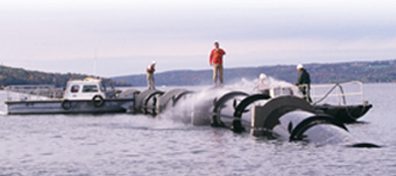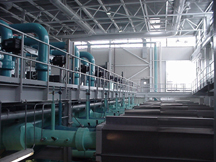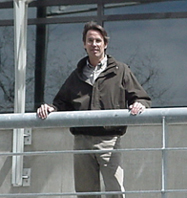 On a cool spring
day in Ithaca, N.Y., engineer Lanny Joyce sits at his computer to keep an eye
on the system cooling the Cornell University campus 2 miles away. The system
is not a usual air conditioner. Every minute, 7,000 gallons of cold water from
the bottom of Cayuga Lake travel to the shoreline through an underwater and
underground pipe system, cooling a separate closed water loop that goes up to
campus, keeping the students and faculty cool in their final days of the semester.
On a cool spring
day in Ithaca, N.Y., engineer Lanny Joyce sits at his computer to keep an eye
on the system cooling the Cornell University campus 2 miles away. The system
is not a usual air conditioner. Every minute, 7,000 gallons of cold water from
the bottom of Cayuga Lake travel to the shoreline through an underwater and
underground pipe system, cooling a separate closed water loop that goes up to
campus, keeping the students and faculty cool in their final days of the semester.
A major part of construction was the deployment of more than 12,000 trench feet of piping between Cayuga Lake and the Cornell campus. Stolt Comex Seaway engineers stand on the Lake Source Cooling intake pipeline to verify the pipe position as it sinks into the lake. Concrete ballast and stiffening collars lie at 15-foot intervals on the pipe. Pusher boats on the sides moved the pipe around into position.
Joyce’s eyes beam through his oval-shaped glasses at the screen as he boasts of the energy-saving benefits of the two-year-old Lake Source Cooling (LSC) system over the old refrigeration system developed in the 1960s. Since LSC began in July of 2000, Cornell has been using 85 to 90 percent less electricity to cool the campus.
“This is it, the thing I always I love to look at: 0.084 kilowatts per ton of air conditioning. When we were running refrigeration, the total system efficiency averaged near 0.7 and on a hot day approached 1.0 kilowatts per ton,” Joyce says. “I get to look at this 85 percent reduction every day.”
Cayuga Lake sits in a glacially carved valley in central New York. At 38 miles long and 435 feet deep, it is the second largest of the six New York Finger Lakes. It is the backdrop and main player in a $57-million cooling project for Cornell.
During the summer, the lake’s surface heats up, but at 250 feet deep, the waters maintain a year-round temperature of about 39 degrees Fahrenheit. In 1994, Joyce and other Cornell staff first envisioned using Cayuga’s cool waters as a less expensive, non-CFC, renewable energy source for cooling Cornell’s campus as an alternative to the refrigeration based chilled-water system. The old system used three chilled water plants and a 4.4 million-gallon thermal storage tank to air condition Cornell with CFC refrigerants.
The Ithaca community met their idea with caution and some resistance, fearful that the project might alter the beauty and ecology of the Finger Lake. After extensive environmental assessments, the University and New York Department of Environmental Conservation approved the project in January of 1998. Since the controversial project’s operation began two years ago, LSC has come full circle — now winning praise from engineers and environmentalists alike.
This year, among its many accolades, the Cornell Utilities Department won the 2001 New York Governor’s Award for Pollution Prevention. LSC eliminates the need for about 20 million-kilowatt hours of electricity a year — enough power to serve 2,500 homes a year. Joyce says he believes the beauty of LSC lies in its simplicity.
How it works
 LSC consists
of two loops, one carrying water between the lake and the LSC plant on shore
and one closed loop between the plant and campus. The Cornell water and lake
water never mix. Once on campus, the chilled water winds around a closed loop
of pipes and collects the heat removed by air conditioning in the buildings.
LSC consists
of two loops, one carrying water between the lake and the LSC plant on shore
and one closed loop between the plant and campus. The Cornell water and lake
water never mix. Once on campus, the chilled water winds around a closed loop
of pipes and collects the heat removed by air conditioning in the buildings.The heat exchange facility serves as home base for the Cornell University Lake Source Cooling Project. The project has replaced refrigeration to air condition the college campus two miles away. Photo by Lisa M. Pinsker
The onshore LSC plant pumps the 39-degree Fahrenheit lake water to a heat exchanger, where it absorbs some of the heat from the closed loop from Cornell, before the water returns to the lake. The 55-degree Fahrenheit water enters the lake at a shallow depth. “The last 100 feet of the outfall has diffusers on it — 38 nozzles that are small in diameter that direct the water and also induce lake water to mix with it, so it quickly returns to the ambient condition,” Joyce says. It turns out, Joyce adds, that the water coming out of the LSC plant is actually colder, clearer and lower in nutrients than what is already in the lake during the summer months when flow is highest. And the actual amount of heat added back into the lake is equivalent to two additional hours of sunlight each year.
The open lake loop starts at an intake pipe 250 feet below the lake surface, 10 feet above the lake bottom in water 2 miles from the plant. The intake designers, Makai Ocean Engineering, planned deployment of the piping from the surface using a controlled sink process that pumped water in at the shallow end and released air at the other.
At the beginning of design, Makai required piston coring to survey Cayuga’s sediment composition. Joyce says that it was essential to insure that the piping infrastructure would not sink into the sediments, otherwise it would have been impossible to retrieve the intake pipe. In addition to conducting formal geotechnical tests, Makai engineers placed a cinder block on the lake bottom to see how much it would sink into the sediments. Also, they dropped the block from 15 feet above the lake bottom and measured the difference in settling. An underwater, remotely operated vehicle photographed the block. Both tests revealed very minimal sinking. Later retrieval operations confirmed that the lake bottom was supporting the piping. Since the pipe deployment in fall of 1999, they’ve filmed the piping underwater three times. “The pipe is sitting in exactly the same position as original deployment,” Joyce says.
The intake features some biological adaptations. An octagon-shaped fine screen about the size of a house covers the pipe to keep fish out. The screen can come up the surface for mechanical cleaning should zebra mussels accumulate in the pipe. Also, a low-wattage light acts to deter mysids, tiny freshwater shrimp.

 In addition
to the Governor’s Award, the LSC project and team have received honors
from the American Society of Civil Engineers, New York State Society of Professional
Engineers, the International District Energy Association and the American Society
of Heating Refrigerating and Air-Conditioning Engineers. Many longtime critics
of the project, however, are still not swayed by these recent honors, according
to a recent article in the Ithaca Journal. Despite the community’s
sometimes lukewarm acceptance, community input and participation has resulted
in a new park on the lakeshore across from the LSC plant, nearly 3,000 feet
of new road and utility infrastructure in Ithaca, and a continuous walking path
from campus down to the lake shore. The system also cools the local Ithaca High
School.
In addition
to the Governor’s Award, the LSC project and team have received honors
from the American Society of Civil Engineers, New York State Society of Professional
Engineers, the International District Energy Association and the American Society
of Heating Refrigerating and Air-Conditioning Engineers. Many longtime critics
of the project, however, are still not swayed by these recent honors, according
to a recent article in the Ithaca Journal. Despite the community’s
sometimes lukewarm acceptance, community input and participation has resulted
in a new park on the lakeshore across from the LSC plant, nearly 3,000 feet
of new road and utility infrastructure in Ithaca, and a continuous walking path
from campus down to the lake shore. The system also cools the local Ithaca High
School.